Japanese shadows
Just before the month of January totally disappears, I’m back with my second #sewjapaneseinjanuary project, which I’m a little disappointed in. I foolishly thought that this was a simple style and I wouldn’t need to toile it. Famous last words…
The pattern is from a Japanese sewing book by Michiyo Ito. It’s another book from the Heartwarming Life Series and is titled May Me. I’m wearing a version of the top on page 17.
Can you see where I’ve deviated from the pattern? There is a reason the model has her hands in her pockets!
If you sewed up this top as per the instructions in the book, you wouldn’t have the ability to move your arms in any upward direction without flashing most of your mid section. As I like to be able to wave, reach the top shelf at the supermarket and peg washing on the clothes line without flashing any flesh, I opted not to included the elastic in the arm openings. This is what I call an on-the-fly mid construction change of plan!
I have a bad habit of buying beautiful cotton voiles and not sewing them up because they are a little see through and I don’t want to line them. I was quietly hoping this pattern would be a winner for light-weight cottons, but unfortunately I hate how it blouses when it rides up a little. I’ve tried various different elastic lengths in the hem, but to no avail. I’m wondering if the top had extra length (this is why I’m kicking myself I didn’t toile) would it have made a difference? Maybe a more drapey fabric would have worked? Your thoughts?
To end on a positive note, I thought I might share my answers to a few of the questions that I often get asked about Japanese sewing patterns…
Where do you buy these books from? I buy from an Etsy Seller or from the Japanese Bookstore Kinokuniya. Kinokuniya have stores in Sydney and Singapore. I live in Melbourne, but whenever I’m in Syndey, Kinokuniya is a ‘must visit’. My husband occasionally visits Singapore for work and I give him my ‘wish list’ and send him off on a Japanese sewing book hunt. Some of my fellow Australian sewing friends have had success with Amazon Japan which I have just discovered has an English site!
Do you speak Japanese? I don’t speak Japanese. I find that the diagrams in Japanese sewing books are so detailed that I don’t need written instructions. I will just say that my preference is for visual learning and I understand that this won’t suit everyone. If you are unsure, I would suggest trying one of the English translated Japanese sewing books (maybe your local library has a copy you could borrow?) and seeing if you can sew a garment by just following the diagrams.
Any advice for newbies? Two invaluable resources if you are new the sewing Japanese patterns are the Dictionary of Japanese Sewing Terms and Understanding a Typical Japanese Sewing Pattern.
Do you have to trace the patterns? Most Japanese pattern books come with two or three double sided pattern sheets. If you are familiar with Ottobre or Burda Magazine pattern sheets they very similar. For the uninitiated, the pattern sheets look like a red hot mess, but if you spend a bit of time studying them, you will be able to find the pieces you are after. The good news is, Japanese patterns are often very simple styles and don’t have many pattern pieces.
Are seam allowances included? You will need to add seam and hem allowances to the pattern pieces that you trace. The cutting diagram will indicate where you need to add seam/hem allowances and offer a suggestion of how much. If no amount is suggested my default is 1cm or 3/8″.
Can you remind where those free Nani Iro patterns are? Nani Iro releases several free kids, adults and homeware patterns with each of their seasonal fabric releases. The patterns are usually an A4 sheet (like below) where you are given the measurements, but have to draft them up yourself.
Pattern: Top on page 17 from Heart Warmining Life Series : May Me (ISBN 978-4-529-05543-7)
Fabric: Cotton voile remnant from Tessuti
Alterations: Removed 1 & 3/4″ (4cm) from the length. Didn’t add elastic to the sleeve openings.
Accessories: Antique beads and shoes from Florsheim
Location: Ballarat Civic Centre

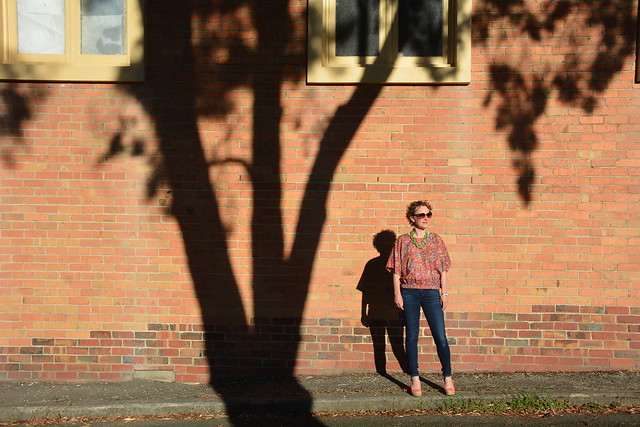
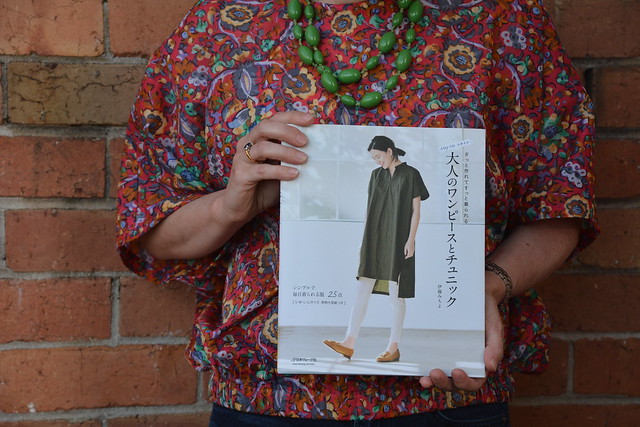
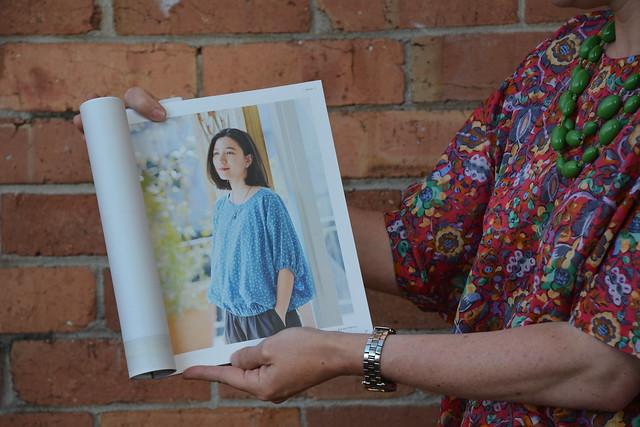

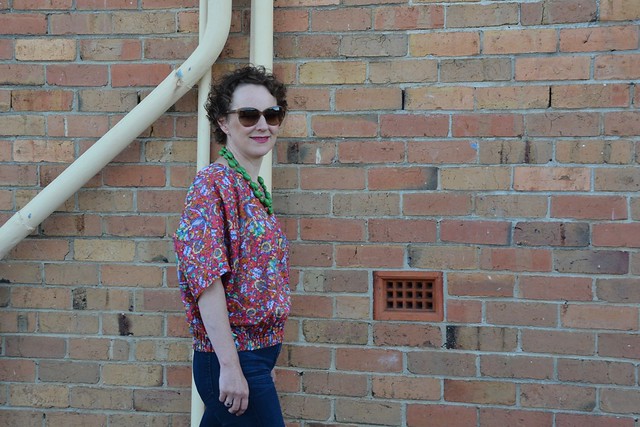


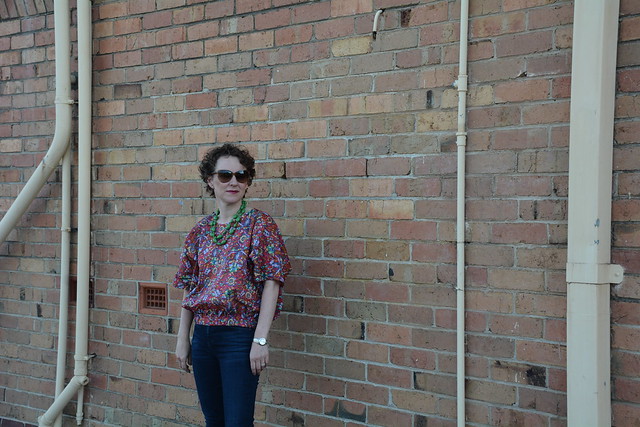
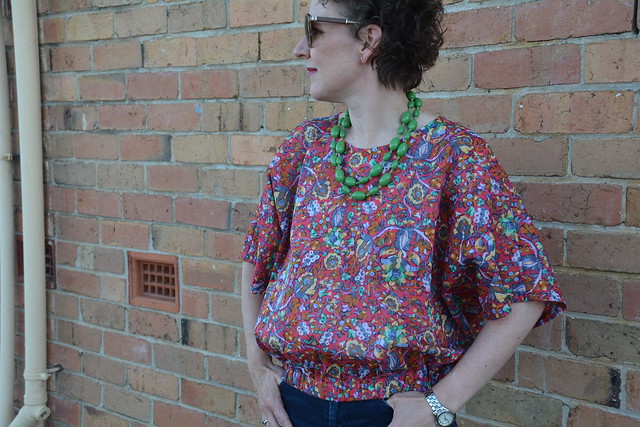

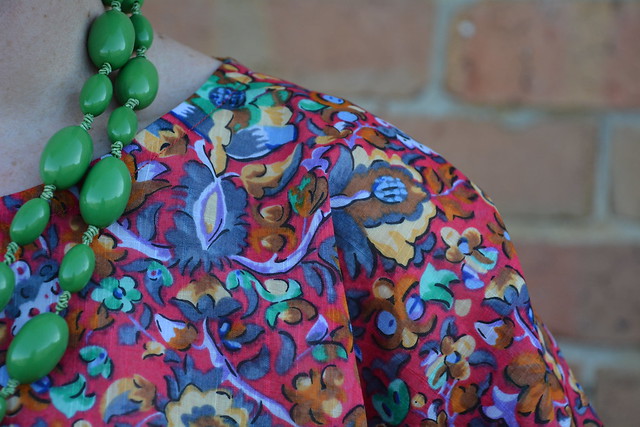

How frustrating! I wonder whether there’d be less pooching with a knit, or something more slinky…. thanks for the little roundup of advice. I’m sorry I didn’t get my butt into gear to join you!
I have a RTW top which had a similar problem: ie rode up when I moved and bloused a lot. Drove me nuts. Like you, I played around with different lengths of elastic, but in the end I took it out completely and it became a much more comfortable and wearable tent style.
How do you think yours would look if you took the elastic out of the hem, but inserted elastic into the sleeves and maybe narrow the sides??
Have you considered adding a band to the bottom to give more length, then make a channel in the bottom and elasticate that? Not very well explained, add say a 3″ band and channel a half inch at the bottom for a fine run of elastic. Try inserting a couple of lengths of shirring elastic instead, joined before running through, as that will bring it in, but with minimal stretch! The blouse is really beautiful, and as you say, you do need to move!!
I love it Anna!
I think it’s a lovely top and would definitely wear it, the fabric is lovely but it’s a shame it’s not quite right. It’s so frustrating when things don’t go to plan. I have one Japanese book and made a top from it ages ago, I think I should dig it out and have another look.
wonder if its worth putting a fixed and slightly pleated band around the bottom – the pleats to reduce some of the width, the band to make it a wee bit longer
Yeah I can relate to the frustration you must have felt … but the fabric is lovely and it would be such a shame for it not to get worn … like Sue I would take out the elastic and and maybe lengthen it … add a ruffle of something
OMG this pattern is super cool!
Thank you for sharing tips on how to find these Japanese books.
Xo
http://www.alchimistihandmade.com
I have a cupboard full of cotton voiles that I think are too see through to use also. I have stopped buying them now. Now that you have pointed it out, I can see that the original pattern is flawed, but I would not have guessed this and made it without a toile too. I’m glad you made it work for you.
Thanks Katherine. It definitely is a sewing journey at times!
I think the only way for it not to ride up at the bottom is for the elastic not to actually function. I.e for the band to be so loose as to not ‘cinch’ in at all – just gathered and hanging (does that make sense?!). I’ve seen this around even in rtw – the elastic gives it weight and shape, but it isn’t stretched or anything so it moves up and down back into place with you as you move your arms etc. It’s a different look but it solves the problem! The voile is very pretty though, and so good in this diabolical weather!
I think you’re absolutely right Zoe. Thanks.